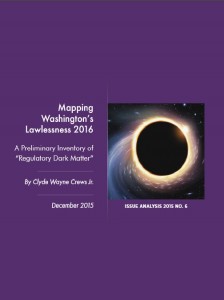Are they lying, or just being economical with the truth? Did that fall off the back of a truck, or was it stolen? Does he need more time with the family, or was he fired? Was the animal put to sleep, or killed?
We commonly use such euphemisms to make our point without being crass. Many of these expressions are charming, even poetic – the birds and the bees, the call of nature, or full-figured, for example. Nowhere is the technique more polished than in the halls of government, where there are dozens of ways to describe taxes, regulations, and penalties. These days, government workers being terminated as part of an effort to reduce spending are being “balanced out.” Tax increases are called “revenue enhancements,” and regulations are called “guidance.”
There is nothing charming or poetic about the many ways government disguises its rules and regulations. But the various names are important now, because of the current priority to scale back over-regulation. The new President placed a temporary moratorium on new regulations, and has ordered that any new rule be accompanied by the repeal of two existing ones. Congress has passed ten resolutions disapproving recent regulations, and is set to review many more. And several new Department Secretaries are requiring better cost-benefit analyses of all new regulations. Thus, it has become a serious problem to figure out exactly what constitutes a “regulation.”
 What perfect timing for this month’s release of an updated report from the Competitive Enterprise Institute (CEI), authored by Clyde Crews, tracking dozens of types of “regulations” issued by hundreds of federal agencies. There are several thousand official “regulations” published in the Federal Register and subject to public comment before final adoption – but there are even more “unofficial” rules. There are literally thousands of decrees, edicts, and proclamations issued as memoranda, guidance documents, directives, news releases, bulletins, notices, circulars, manuals, and my favorite, “administrative interpretations.” Some of these are also published in the Federal Register or the Code of Federal Regulations, but most are not. Nor is public comment invited on them. Agency guidelines are often sent only to regional or field offices, and the public might find out about new rules only when they are enforced.
What perfect timing for this month’s release of an updated report from the Competitive Enterprise Institute (CEI), authored by Clyde Crews, tracking dozens of types of “regulations” issued by hundreds of federal agencies. There are several thousand official “regulations” published in the Federal Register and subject to public comment before final adoption – but there are even more “unofficial” rules. There are literally thousands of decrees, edicts, and proclamations issued as memoranda, guidance documents, directives, news releases, bulletins, notices, circulars, manuals, and my favorite, “administrative interpretations.” Some of these are also published in the Federal Register or the Code of Federal Regulations, but most are not. Nor is public comment invited on them. Agency guidelines are often sent only to regional or field offices, and the public might find out about new rules only when they are enforced.
The CEI report is called “Mapping Washington’s Lawlessness: An Inventory of Regulatory Dark Matter.” It is debatable whether agencies issuing such unofficial rules are really being “lawless,” in the sense that Congress could stop it at any time, and has not done chosen to do so. But “regulatory dark matter” is a great analogy. In space, dark matter is something we cannot see or measure, but we know it is there because of its gravitational effects on everything that we can see and measure. Similarly, some government rules and procedures may not technically be official regulations, but they nevertheless carry the force of law, including civil or criminal penalties.
When the Education Department required school districts to allow students to use whichever restroom they chose, that was a guidance document called a “dear colleague” letter. When the Labor Department decided that independent contractors would be treated as employees, it was a new “administrative interpretation.” The EPA’s now-infamous “Waters of the U.S.” rule was an “interpretive guidance” document. EPA’s blatant take-over of future investment decisions by Volkswagen was done through a legal settlement decree. The Council on Environmental Quality proposed a “Draft Guidance for Greenhouse Gas Emissions and Climate Change Impacts,” which would essentially implement Obama-era climate policies through changes in federal land management. In all of these cases and thousands more, Congress never specifically authorized the policies, nor were they issued as actual “regulations” in the legal sense. But when issued they became law; they direct human activity; and there is a price for violating them.
The CEI report seeks to ensure that Congress and the Administration, in their effort to rein in federal regulatory overreach, remember to include such “dark matter” in its definition of the term. Then, the review and approval processes would include not only official regulations published in the usual way, but also these agency “guidelines” and other categories, making them all subject to similar scrutiny.
It doesn’t matter whether something is called a rule or not. If you have to comply with it and can be punished for violating it, it’s a rule. Thus, it should be adopted through the regular public process – by the consent of the governed.
Juliet said to Romeo, “What’s in a name? That which we call a rose, by any other name would smell as sweet.” Indeed. That which we call a regulation, by any other name, still smells like government control.
A version of this column originally appeared inn the Grand Junction Daily Sentinel March 24, 2017.




Comments on this entry are closed.